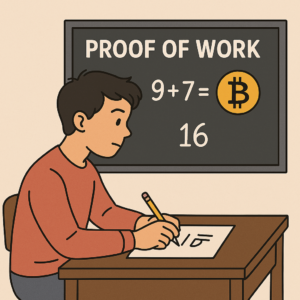Proof of Work: How Crypto Mining Really Works
If you’re interested in crypto mining, especially with GPUs in Canada, you’ve probably heard the term Proof of Work more than a few times. But what does it really mean?
Proof of Work (PoW) is the engine behind many cryptocurrencies — including Bitcoin, Ravencoin, and others. It’s how these networks stay secure, confirm transactions, and fairly distribute rewards. Whether you’re running a single GPU to mine in your basement or building out a full rig, understanding how Proof of Work operates can help you mine smarter.
Let’s break it down.
What is Proof of Work?
Proof of Work is a consensus algorithm — a way for decentralized blockchains to agree on which transactions are valid. It was made famous by Bitcoin but is used by many other coins, especially GPU-mineable ones like Ravencoin (KawPoW), Vertcoin (Verthash), and even newer speculative projects.
In PoW, miners use computing power to solve cryptographic puzzles. Solving one allows a miner to add a new block to the blockchain — and get paid in crypto. The work is “proof” that they contributed energy and hardware to secure the network.
How Proof of Work Mining Actually Works
Here’s a breakdown of how crypto mining works when using a Proof of Work system:
1. Transactions Enter the Network
Every time crypto is sent or received, the transaction is broadcast across the network. Miners collect those transactions into a “block.”
2. Miners Race to Solve the Puzzle
Each block contains a unique cryptographic hash puzzle. Your GPU miner tries billions of possible solutions per second. It’s all brute force — and the more hashes you produce, the better your odds of winning the block.
This is where things like overclocking, undervolting, and algorithm tuning come in. Efficiency matters.
3. First Miner to Solve It Earns the Reward
Once a miner finds the solution, it’s shared with the rest of the network. If verified, the block is added to the blockchain, and the winning miner earns the block reward (plus transaction fees).
4. The Chain Continues
Now the process resets, and miners compete to solve the next block.
Why GPUs are Perfect for Proof of Work
Some PoW coins are designed to be ASIC-resistant, meaning they favor general-purpose GPUs over expensive, single-purpose hardware. This keeps mining decentralized — something that’s great for hobbyists and solo miners like us here in Canada.
Coins like:
-
Ravencoin (KawPoW)
-
Vertcoin (Verthash)
-
Firo (FiroPoW)
…are great examples of GPU-friendly Proof of Work projects.
Difficulty and Network Security in PoW
The beauty of Proof of Work is that it naturally adjusts to keep things balanced. If more miners join the network, the difficulty increases. If miners leave, it lowers. This ensures blocks are produced at consistent time intervals.
Mining profitability depends on:
-
Network difficulty
-
Block rewards
-
Coin price
-
Power costs (check your Canadian province rates)
-
GPU efficiency (MH/w)
How Proof of Work Keeps Crypto Secure
PoW is secure because it’s expensive to cheat. You’d need to outwork the entire network — consuming tons of electricity and computing power — just to manipulate one block. The deeper a block is in the chain, the harder it is to change.
This is why 51% attacks (where one miner controls over half the network) are so rare — the cost of pulling it off is massive.
Why Proof of Work Matters for Canadian Miners

If you’re mining in a cold climate like Manitoba or Alberta, you’re in a great position to make PoW mining work for you. The heat from your GPUs offsets your heating bill, and the crypto rewards (even small ones) stack up over time.
You’re not just earning coins — you’re contributing to network security, decentralization, and a global financial experiment. That’s the power of Proof of Work.
Final Thoughts
Whether you’re spec mining new coins or stacking Ravencoin every day, understanding Proof of Work is the foundation of successful GPU mining. It’s what powers your rig — and keeps the blockchain honest.
Got questions? Leave a comment or check out my Beginner’s Guide to Crypto to get started.
📩 Sign up for our newsletter to stay updated on blockchain trends, crypto mining tips, and more!

Pingback: What is a Blockchain? - canadiancryptomining.com
Pingback: What are Altcoins? - canadiancryptomining.com
Pingback: What is Bitcoin? - canadiancryptomining.com